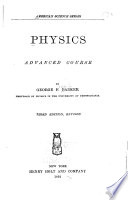 | 1891 - 1590 pages
...are at a finite distance apart than when they are infinitely distant from one another, by an amount which is directly as the product of their masses and inversely as their distance apart. This statement, it is to be particularly observed, contains no allusion to attraction... | |
 | Walter William Rouse Ball - 1889 - 308 pages
...History of mathematics, London, 1888. universe attracts every other particle with a force which varies directly as the product of their masses and inversely as the square of the distance between them ; and he thence deduces the law of attraction for spherical shells of constant... | |
 | Walter William Rouse Ball - 1889 - 328 pages
...every particle of matter attracts every other particle, and he suspected that the attraction varied as the product of their masses and inversely as the square of the distance between them. He also worked out the fluxional calculus tolerably completely: thus in a manuscript... | |
 | William Garnett - 1889 - 344 pages
...unit of force. The law of gravitation is, that the attraction between two material particles varies directly as the product of their masses, and inversely as the square oi the distance between them. Hence, if mj, m., denote the masses of two particles expressed in terms... | |
 | John Thornton (M.A.) - 1890 - 372 pages
...other particle, with a force whose direction is that of the line joining the two, and whose magnitude is directly as the product of their masses, and inversely as the square of their distances from each other.' This theory receives such enormous authority from its power of explaining... | |
 | William McKendree Bryant - 1890 - 334 pages
...other particle with a force, whose direction is that of the line joining the two, and whose magnitude is directly as the product of their masses, and inversely as the square of their distance from * See Whewell, "HM. of InditeUve Sciences," 3d (NY) Ed., I., 549. each other."*... | |
 | Robert Chambers - 1890 - 848 pages
...force whose direction is that of the straight line joining the two, and whose magnitude is proportional directly as the product of their masses, and inversely as the square of their mutual distance. Previous to Newton's investigations, Kepler, by a truly prodigious amount of... | |
 | University of Toronto. Mathematical and Physical Society - 1891 - 136 pages
...particle of matter in the universe attracts every other particle of matter, with a force which varies directly as the product of their masses and inversely as the square of their distance) an hypothesis which explained and will, in all probability, continue to explain certain... | |
 | Otto Dziobek - 1892 - 316 pages
...reads as follows: Each particle of matter attracts any other particle with a force whose magnitude is directly as the product of their masses and inversely as the square of their distance from each other. Assume that P, and P2 are two gravitating particles, the coordinates... | |
 | George Frederick Barker - 1892 - 932 pages
...other particle with a force whose direction is that of the line joining the two, and whose magnitude is directly as the product of their masses and inversely as the square of their distance from each other." Common observation teaches us that all the phenomena about us which... | |
| |